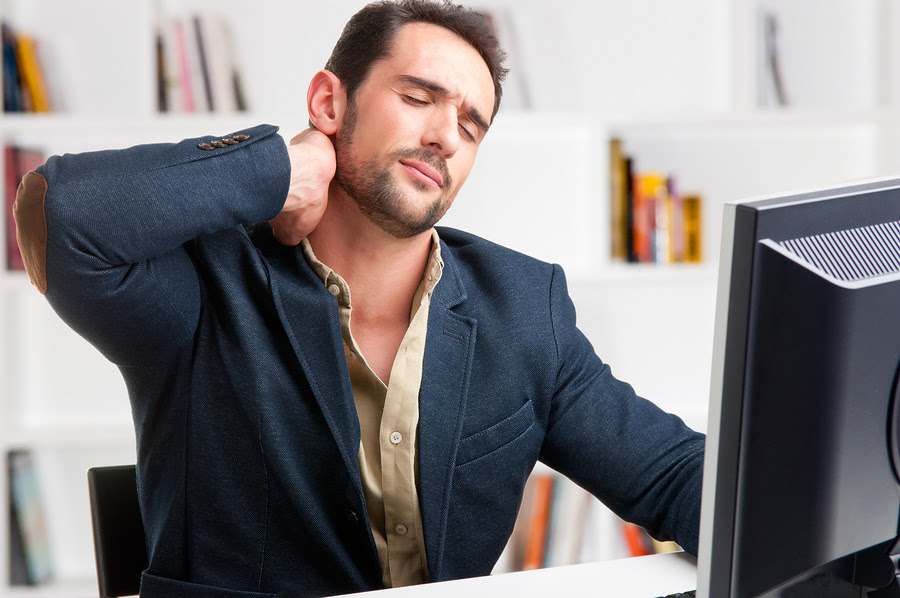
6 ways to ease neck pain |

Image: Wavebreakmedia/iStock
Everyday life isn't kind to the neck. You may be all too familiar with that crick you get when you cradle the phone between your shoulder and ear, or the strain you feel after working at your computer.
Neck pain rarely starts overnight. It usually evolves over time. And it may be spurred by arthritis or degenerative disc disease and accentuated by poor posture, declining muscle strength, stress, and even a lack of sleep, says Dr. Zacharia Isaac, medical director of the Comprehensive Spine Care Center at Harvard-affiliated Brigham and Women's Hospital and director of interventional physical medicine and rehabilitation at Harvard Medical School.
The following six tips can help you take care of your neck.
- Don't stay in one position for too long. It's hard to reverse bad posture, Dr. Isaac says, but if you get up and move around often enough, you'll avoid getting your neck stuck in an unhealthy position.
- Make some ergonomic adjustments. Position your computer monitor at eye level so you can see it easily. Use the hands-free function on your phone or wear a headset. Prop your tablet on a pillow so that it sits at a 45° angle, instead of lying flat on your lap.
- If you wear glasses, keep your prescription up to date. "When your eyewear prescription is not up to date, you tend to lean your head back to see better," Dr. Isaac says.
- Don't use too many pillows. Sleeping with several pillows under your head can stifle your neck's range of motion.
- Know your limits. For example, before you move a big armoire across the room, consider what it might do to your neck and back, and ask for help.
- Get a good night's sleep. Sleep problems increase the risk for several different conditions, including musculoskeletal pain.
Generally, neck pain is nothing to worry about. But if it's occurring with other, more serious symptoms, such as radiating pain, weakness, or numbness of an arm or leg, make sure to see your doctor. "Other key things that might make one more concerned are having a fever or weight loss associated with your neck pain, or severe pain. You should let your doctor know about these symptoms," Dr. Isaac says.
For more information on managing a stiff, achy neck, buy Neck Pain, a Special Health Report from Harvard Medical School.
The 7 faces of neck pain |

Image: iStock
If you're bothered by neck pain, you have plenty of company. Doctors estimate that seven out of 10 people will be troubled by such pain at some point in their lives. But if you were to ask each of these people to describe their neck pain, you would probably get seven different stories.
By clearly describing your specific neck symptom, or combination of symptoms, you can help your doctor determine what's wrong and how to help.
Here are the most common types of neck pain.
- Muscle pain. Aching or sore neck and shoulder muscles may occur in response to overexertion or prolonged physical or emotional stress. The neck muscles may develop hard knots that are tender to the touch, sometimes called trigger points.
- Muscle spasm. This is a sudden, powerful tightening of neck muscles. Your neck may hurt and feel tight or knotted, and it may be impossible to turn your head. When you wake up with a painful, stiff neck, that's likely a muscle spasm. Muscle spasm can result from a muscle injury, but it may also occur in response to a spinal disc or nerve problem, or even emotional stress. However, there is often no clear cause.
- Headache. Neck-related headache is most often felt in the back of the head and upper neck and is usually the result of muscle tension or spasm. Neck-related headache pain is usually dull or aching, rather than sharp; the neck might also feel stiff or tender. Moving your neck makes it worse.
- Facet joint pain. Often described as deep, sharp, or aching, pain in the facet joints (part of the vertebrae of the neck) typically worsens if you lean your head toward the affected side, and may radiate to your shoulder or upper back. Arthritis in the facet joints, as in other locations, may feel worse in the morning or after a period of inactivity.
- Nerve pain. Irritation or pinching of the roots of the spinal nerves causes pain that may be sharp, fleeting, severe, or accompanied by pins and needles. Depending on the nerve involved, the pain may shoot down the arm or even into the hand.
- Referred pain. Referred pain is pain in one part of the body that is triggered by a problem in another part of the body. For example, neck pain that worsens with exertion may indicate a heart problem, while neck pain that occurs when you eat may stem from a problem in the esophagus.
- Bone pain. Pain and tenderness in the cervical vertebrae are far less common than neck pain from the soft tissues. Bone pain needs medical attention because it may signal a more serious health problem.
There are many things you and your doctor can do to manage and relieve your pain, including a combination of self-help techniques and over-the-counter pain medications.
For more information on beating neck pain and getting back to the activities you love, buyNeck Pain, a Special Health Report from Harvard Medical School.

Neck Pain
Featured content:
| • | Where bone, muscle, and nerve converge |
| • | Evaluating neck pain |
| • | Common causes of neck pain |
| • | Managing your pain |
| • | SPECIAL SECTION: Preventing further neck pain |
| • | ... and more! |
Click here to read more »






















.png)











No hay comentarios:
Publicar un comentario